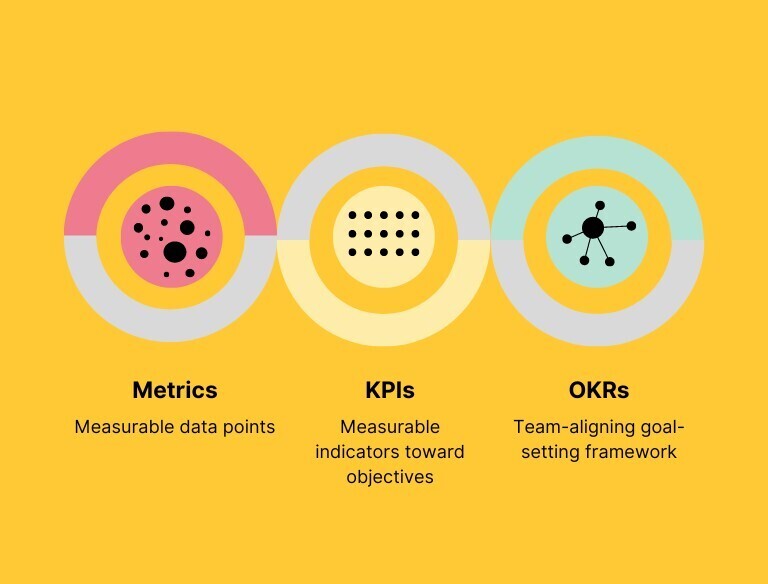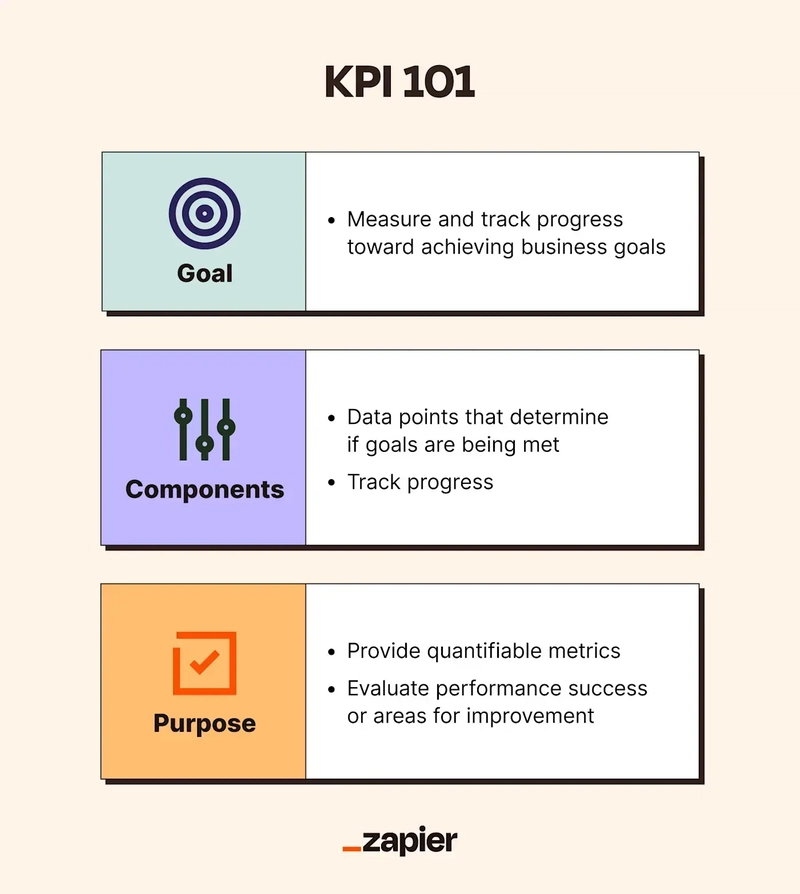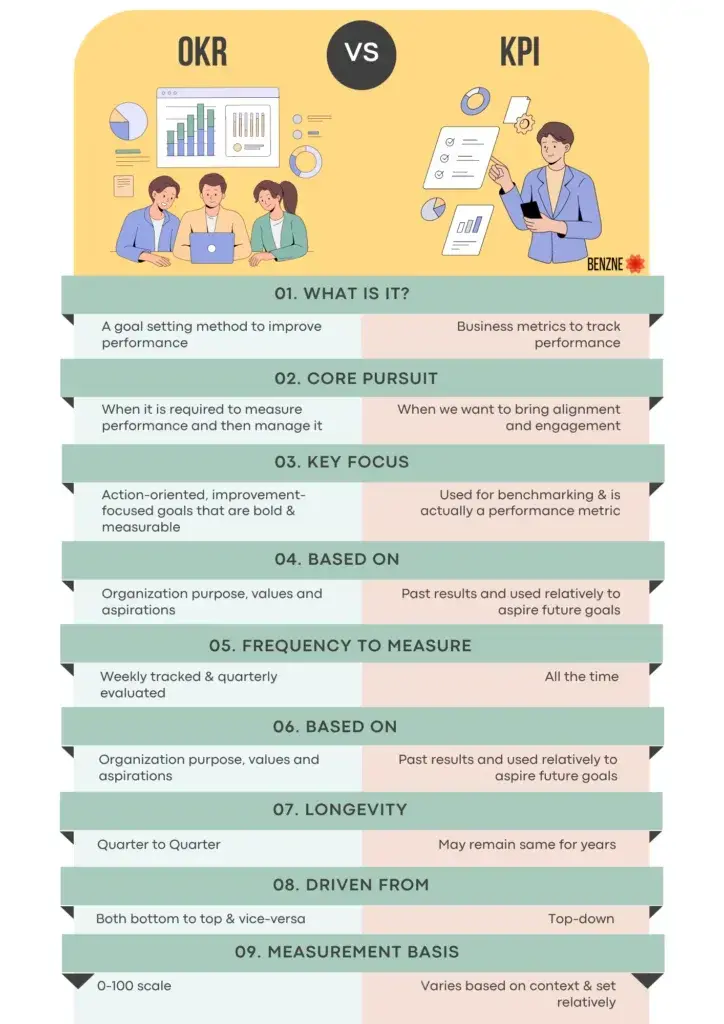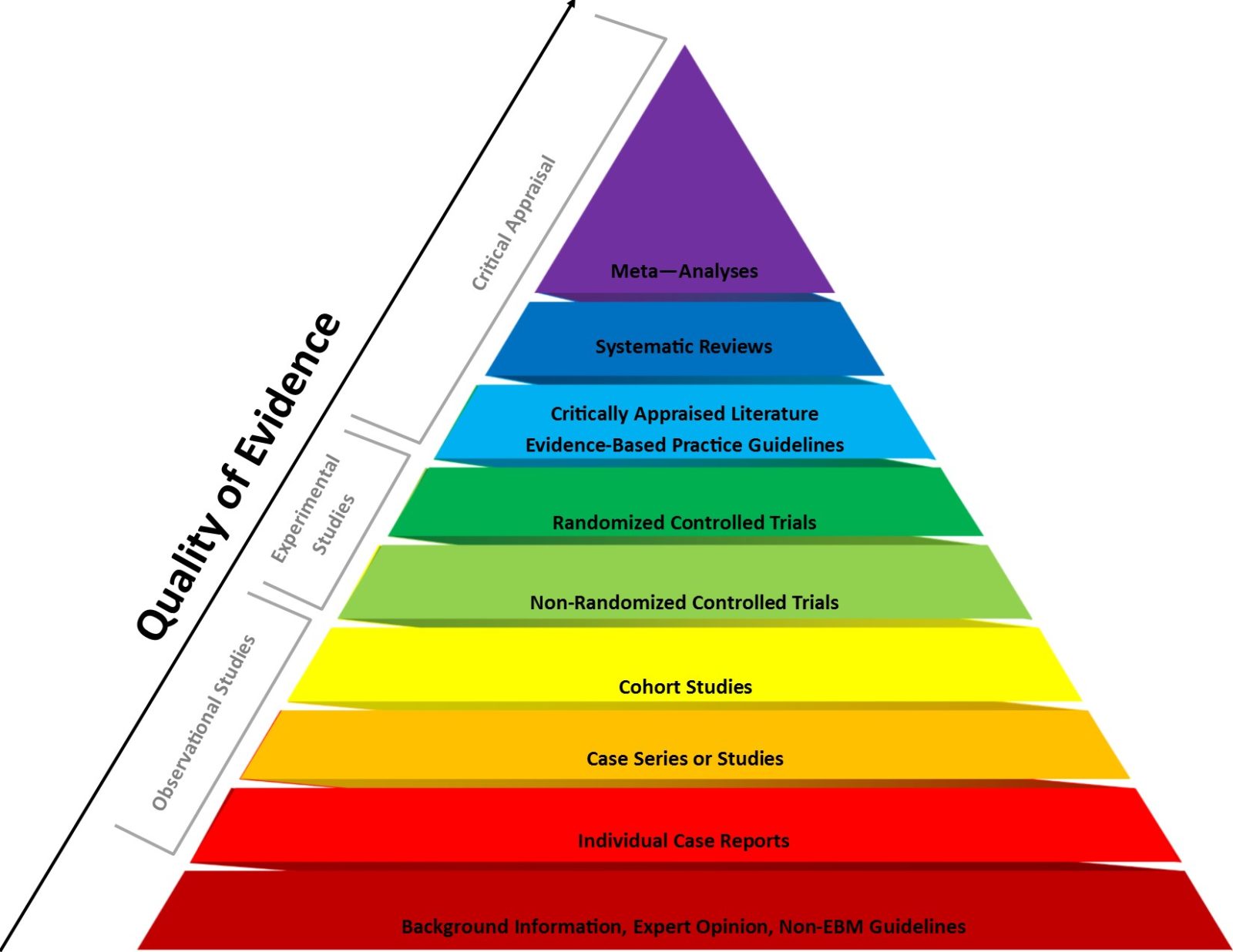OKRs vs. KPIs: Setting Effective Goals for Developer Teams
Table of Contents Understanding OKRs for Developer Teams Understanding KPIs for Developer Teams Key Differences Between OKRs and KPIs When to Use OKRs vs KPIs for Developer Teams Implementing OKRs and KPIs with Teamcamp Best Practices for Setting Effective Developer Goals Real-World Success: How Development Teams Use OKRs and KPIs Conclusion: Choosing the Right Approach for Your Team Introduction Measuring and improving developer productivity has become crucial for success in today's fast-paced tech environment. As development teams face increasing pressure to deliver high-quality software quickly, having the proper goal-setting framework can make all the difference. Two popular approaches stand out: Objectives and Key Results (OKRs) Key Performance Indicators (KPIs). While both frameworks aim to track progress and drive success, they serve different purposes and work best in various scenarios. Understanding when and how to use each can significantly impact your team's performance and project outcomes. Understanding OKRs for Developer Teams OKRs (Objectives and Key Results) are a dynamic goal-setting framework that helps teams set clear, ambitious goals with measurable results. This approach has gained popularity in tech companies because it balances aspiration with accountability. What Are OKRs? OKRs consist of two main components: Objectives: Qualitative, inspirational goals that define what you want to achieve Key Results: Quantifiable metrics that measure progress toward the objective OKRs offer a clear framework that helps developer teams connect their personal objectives with the company’s overall mission and strategic priorities. They encourage teams to think beyond daily tasks and connect their work to meaningful outcomes. Key Characteristics of OKRs OKRs differ from traditional goal-setting frameworks in several important ways: Dynamic and flexible: OKRs can be adjusted as priorities change or new information emerges Short to medium-term focus: Typically set on a quarterly or annual basis Ambitious by design: OKRs are designed to challenge teams by setting ambitious targets that encourage growth beyond their usual limits. Transparent and collaborative: Everyone can see everyone else's OKRs, fostering alignment OKR Examples for Developer Teams Here are some practical OKR examples that developer teams might use: Objective: Improve application performance and user experience Key Results: Reduce page load time by 40% across all major user flows Decrease API response time by 30% Improve user satisfaction score from 7.2 to 8.5 Objective: Enhance code quality and maintainability Key Results: Increase unit test coverage from 65% to 90% Reduce the number of critical bugs by 50% Implement automated code reviews for 100% of new pull requests Understanding KPIs for Developer Teams KPIs (Key Performance Indicators) are metrics used to evaluate the success of specific activities or processes. They provide a stable, consistent way to measure performance over time. What Are KPIs? KPIs are quantifiable measurements that reflect how well a team or organization is achieving its key business objectives. For developer teams, KPIs typically focus on productivity, quality, and efficiency metrics. Key Characteristics of KPIs KPIs have distinct features that set them apart from OKRs: Stable and consistent: KPIs remain relatively unchanged over long periods Long-term focus: Designed for ongoing performance tracking Department of function-specific: Often tailored to particular teams or roles Directly tied to business outcomes: Closely linked to organizational success metrics Common KPIs for Developer Teams Developer teams typically track KPIs such as: Sprint completion rate Code quality metrics (bugs per feature, test coverage) Deployment frequency Mean time to recovery (MTTR) Lead time for changes Customer satisfaction scores Key Differences Between OKRs and KPIs Understanding the fundamental differences between OKRs and KPIs is help to achieve right Gaols and specific needs. Purpose and Focus OKRs are goal-setting tools that drive change and innovation. They focus on what you want to achieve and how you'll measure success. KPIs, on the other hand, are performance metrics that track ongoing business processes and outcomes. Timeframe and Adaptability OKRs are designed for short to medium-term objectives (typically quarterly) and can be adjusted as circumstances change. KPIs are more static, providing consistent measurement over more extended periods. Scope and Alignment OKRs align with broader organizational goals and encourage cross-functional collaboration. KPIs often focus on specific departmental or functional metrics and may not directly connect to company-wide objectives When to Use OKRs vs. KPIs

Table of Contents
- Understanding OKRs for Developer Teams
- Understanding KPIs for Developer Teams
- Key Differences Between OKRs and KPIs
- When to Use OKRs vs KPIs for Developer Teams
- Implementing OKRs and KPIs with Teamcamp
- Best Practices for Setting Effective Developer Goals
- Real-World Success: How Development Teams Use OKRs and KPIs
- Conclusion: Choosing the Right Approach for Your Team
Introduction

Measuring and improving developer productivity has become crucial for success in today's fast-paced tech environment.
As development teams face increasing pressure to deliver high-quality software quickly, having the proper goal-setting framework can make all the difference.
Two popular approaches stand out:
- Objectives and Key Results (OKRs)
- Key Performance Indicators (KPIs).
While both frameworks aim to track progress and drive success, they serve different purposes and work best in various scenarios. Understanding when and how to use each can significantly impact your team's performance and project outcomes.
Understanding OKRs for Developer Teams

OKRs (Objectives and Key Results) are a dynamic goal-setting framework that helps teams set clear, ambitious goals with measurable results. This approach has gained popularity in tech companies because it balances aspiration with accountability.
What Are OKRs?
OKRs consist of two main components:
- Objectives: Qualitative, inspirational goals that define what you want to achieve
- Key Results: Quantifiable metrics that measure progress toward the objective
OKRs offer a clear framework that helps developer teams connect their personal objectives with the company’s overall mission and strategic priorities. They encourage teams to think beyond daily tasks and connect their work to meaningful outcomes.
Key Characteristics of OKRs
OKRs differ from traditional goal-setting frameworks in several important ways:
- Dynamic and flexible: OKRs can be adjusted as priorities change or new information emerges
- Short to medium-term focus: Typically set on a quarterly or annual basis
- Ambitious by design: OKRs are designed to challenge teams by setting ambitious targets that encourage growth beyond their usual limits.
- Transparent and collaborative: Everyone can see everyone else's OKRs, fostering alignment
OKR Examples for Developer Teams

Here are some practical OKR examples that developer teams might use:
Objective: Improve application performance and user experience
Key Results:
- Reduce page load time by 40% across all major user flows
- Decrease API response time by 30%
- Improve user satisfaction score from 7.2 to 8.5
Objective: Enhance code quality and maintainability
Key Results:
- Increase unit test coverage from 65% to 90%
- Reduce the number of critical bugs by 50%
- Implement automated code reviews for 100% of new pull requests
Understanding KPIs for Developer Teams

KPIs (Key Performance Indicators) are metrics used to evaluate the success of specific activities or processes. They provide a stable, consistent way to measure performance over time.
What Are KPIs?
KPIs are quantifiable measurements that reflect how well a team or organization is achieving its key business objectives. For developer teams, KPIs typically focus on productivity, quality, and efficiency metrics.
Key Characteristics of KPIs
KPIs have distinct features that set them apart from OKRs:
- Stable and consistent: KPIs remain relatively unchanged over long periods
- Long-term focus: Designed for ongoing performance tracking
- Department of function-specific: Often tailored to particular teams or roles
- Directly tied to business outcomes: Closely linked to organizational success metrics
Common KPIs for Developer Teams
Developer teams typically track KPIs such as:
- Sprint completion rate
- Code quality metrics (bugs per feature, test coverage)
- Deployment frequency
- Mean time to recovery (MTTR)
- Lead time for changes
- Customer satisfaction scores
Key Differences Between OKRs and KPIs

Understanding the fundamental differences between OKRs and KPIs is help to achieve right Gaols and specific needs.
Purpose and Focus
OKRs are goal-setting tools that drive change and innovation. They focus on what you want to achieve and how you'll measure success. KPIs, on the other hand, are performance metrics that track ongoing business processes and outcomes.
Timeframe and Adaptability
OKRs are designed for short to medium-term objectives (typically quarterly) and can be adjusted as circumstances change. KPIs are more static, providing consistent measurement over more extended periods.
Scope and Alignment
OKRs align with broader organizational goals and encourage cross-functional collaboration. KPIs often focus on specific departmental or functional metrics and may not directly connect to company-wide objectives
When to Use OKRs vs. KPIs for Developer Teams
Both frameworks have their place in managing developer productivity, but they work best in different scenarios.
When to Use OKRs
OKRs work best when:
- You need to drive significant change or innovation
- Teams need clear direction and motivation
- You want to align individual efforts with company goals
- The environment is dynamic and requires adaptability
For example, suppose your team is launching a new product or implementing a significant architectural change. In that case, OKRs can help focus efforts on the most critical outcomes while allowing flexibility in achieving them.
When to Use KPIs
KPIs are most effective when:
- You need to monitor ongoing performance
- Processes are stable and well-defined
- You want to track long-term trends
- Specific metrics directly impact business success
For instance, tracking deployment frequency, bug rates, and customer satisfaction as KPIs can help ensure your team maintains quality and efficiency in day-to-day operations.
Implementing OKRs and KPIs with Teamcamp reports

Try Teamcamp Reports
Setting effective goals is only part of the equation – you also need the right tools to track progress and keep everyone aligned. This is where platforms like Teamcamp can make a significant difference.
How Teamcamp Supports OKRs
Teamcamp provides a centralized workspace where teams can set, track, and update their OKRs:
- Unified Project Dashboard: Teams can visualize objectives and key results alongside tasks and projects, ensuring everyone understands how their work contributes to broader goals
- Milestone & Deadline Tracking: Set clear timeframes for OKRs and monitor progress toward key milestones
- Customizable Dashboards: Create views that highlight the most critical metrics for each team or project
Managing KPIs Through Teamcamp

For ongoing KPI tracking, Teamcamp offers:
- Real-time Performance Metrics: Monitor key indicators through customizable dashboards that update automatically
- Time Tracking Features: Log hours spent on tasks and generate reports to analyze team productivity
- Resource Allocation Tools: Optimize team assignments based on tracked time and productivity data
Integrating Both Frameworks
The most effective approach often combines OKRs and KPIs. Teamcamp makes this integration seamless by:
- Connecting high-level OKRs to specific tasks and projects
- Providing visibility into both goal progress and ongoing performance metrics
- Enabling teams to adjust priorities based on real-time data
- Supporting agile methodologies with features like sprint planning and backlog management
Best Practices for Setting Effective Developer Goals
Whether you choose OKRs, KPIs, or a combination of both, these best practices will help you implement them successfully.
Start with Psychological Safety
Before implementing any goal-setting framework, ensure your team feels safe taking risks and sharing ideas. Teams with high psychological safety are likelier to set ambitious goals and work collaboratively to achieve them.
Focus on Outcomes, Not Output
Measure what matters – the impact of work rather than just the volume. For developers, this means focusing on metrics like user satisfaction and business value rather than lines of code or number of commits.
Involve the Team in Goal Setting
Goals imposed from above rarely inspire commitment. Involve developers in setting their own objectives and defining how success will be measured. This creates ownership and motivation.
Keep Goals Visible and Accessible
Make OKRs and KPIs visible to everyone. Teamcamp's centralized workspace ensures goals stay at the top of the mind and progress is transparent across the organization.
Review and Adapt Regularly
Set up consistent review sessions to monitor progress and make necessary adjustments along the way. OKRs, in particular, benefit from frequent reviews – typically weekly or bi-weekly.
Balance Ambition with Achievability
While OKRs should be ambitious, they shouldn't be impossible. Aim for objectives that stretch the team but remain within reach with focused effort.
Real-World Success: How Development Teams Use OKRs and KPIs
Companies that effectively implement these frameworks see significant improvements in productivity and outcomes.
One notable example comes from Full Scale, which successfully transitioned over 100 developers to remote work while improving productivity. By implementing clear goals and metrics, they achieved impressive results:
- Sprint completion rates improved from 95% to 98%
- Code review efficiency increased by 40%
- Client satisfaction scores rose from 92% to 97%
- Overall team productivity increased by 27%
Organizations using platforms like Teamcamp to manage their goals and projects report similar benefits:
- 3.2x increase in client satisfaction
- 28% faster project delivery
- 32% reduction in administrative work
- 42% lower overhead costs
Conclusion: Choosing the Right Approach for Your Team
Both OKRs and KPIs offer valuable frameworks for setting and tracking developer goals. OKRs drive innovation and change, while KPIs measure consistent performance over time.
The most effective approach often combines both frameworks:
- Use OKRs to set ambitious quarterly goals that align with company objectives
- Track KPIs to monitor ongoing performance and identify trends
- Implement both through a unified platform like Teamcamp to ensure visibility and alignment
Developing teams can significantly improve productivity, quality, and overall success by thoughtfully implementing these frameworks and supporting them with the right tools.
Ready to transform how your team sets and achieves goals? Explore how Teamcamp can help streamline your goal-setting process, improve collaboration, and boost developer productivity – all in one centralized platform.



















































































